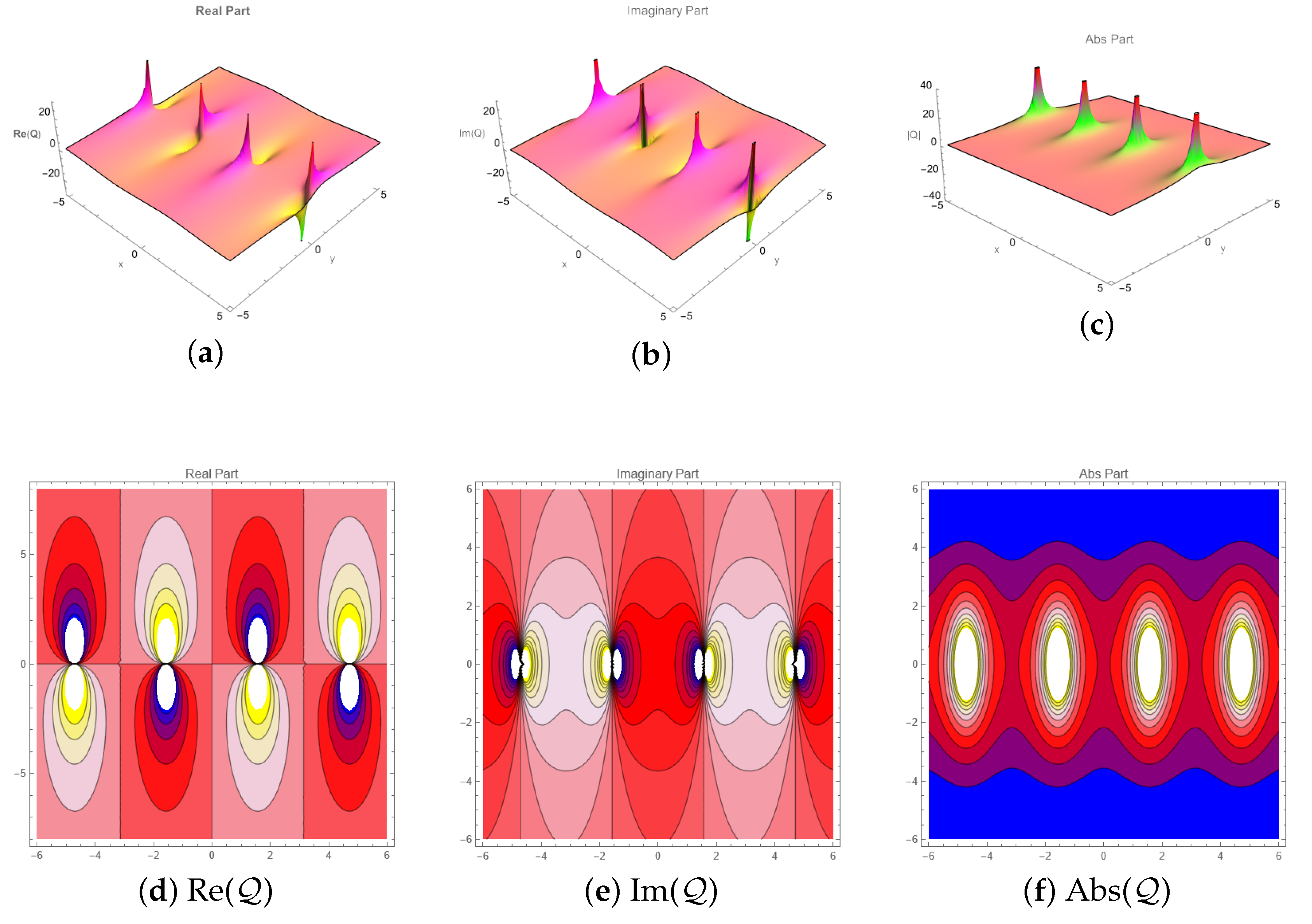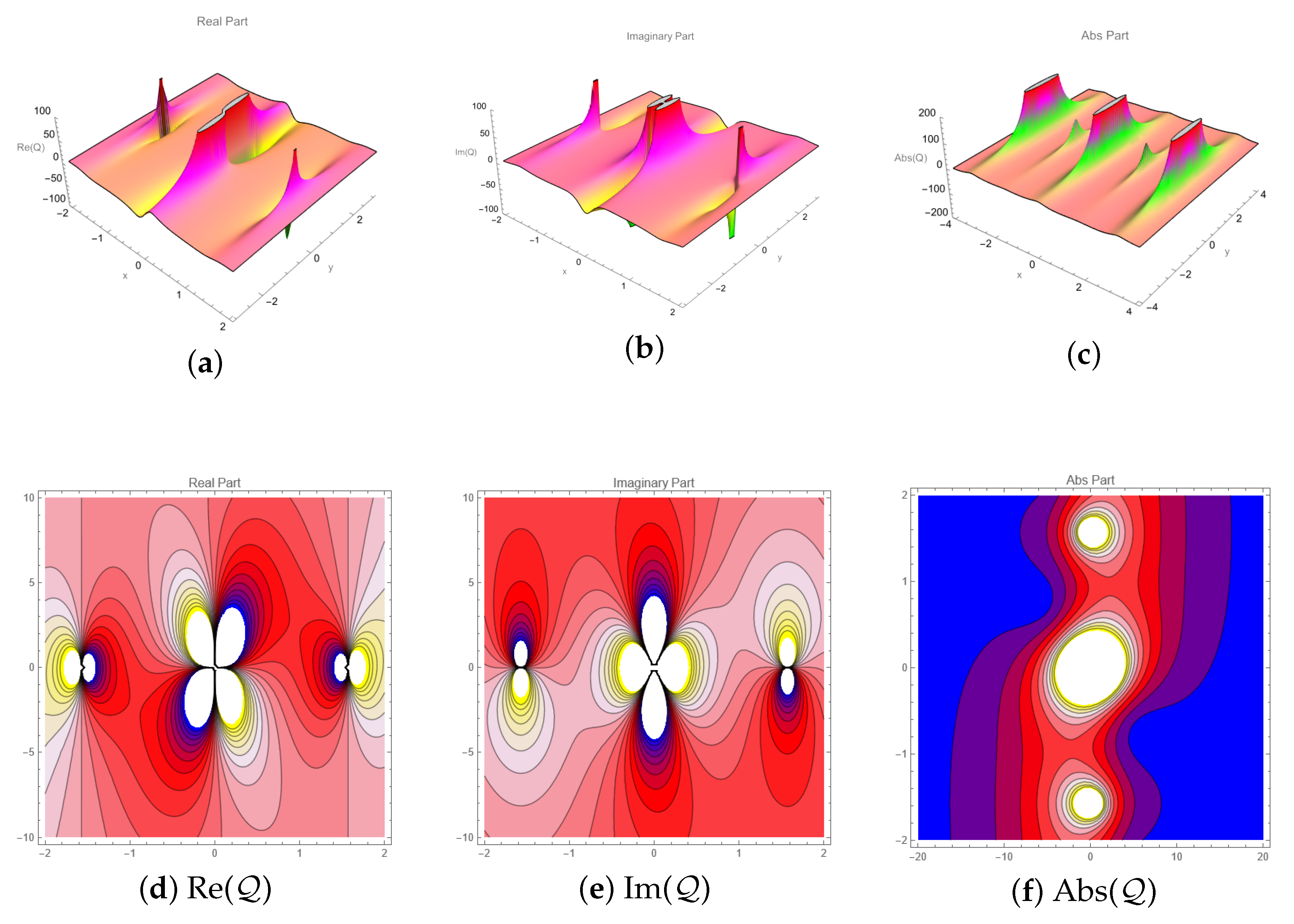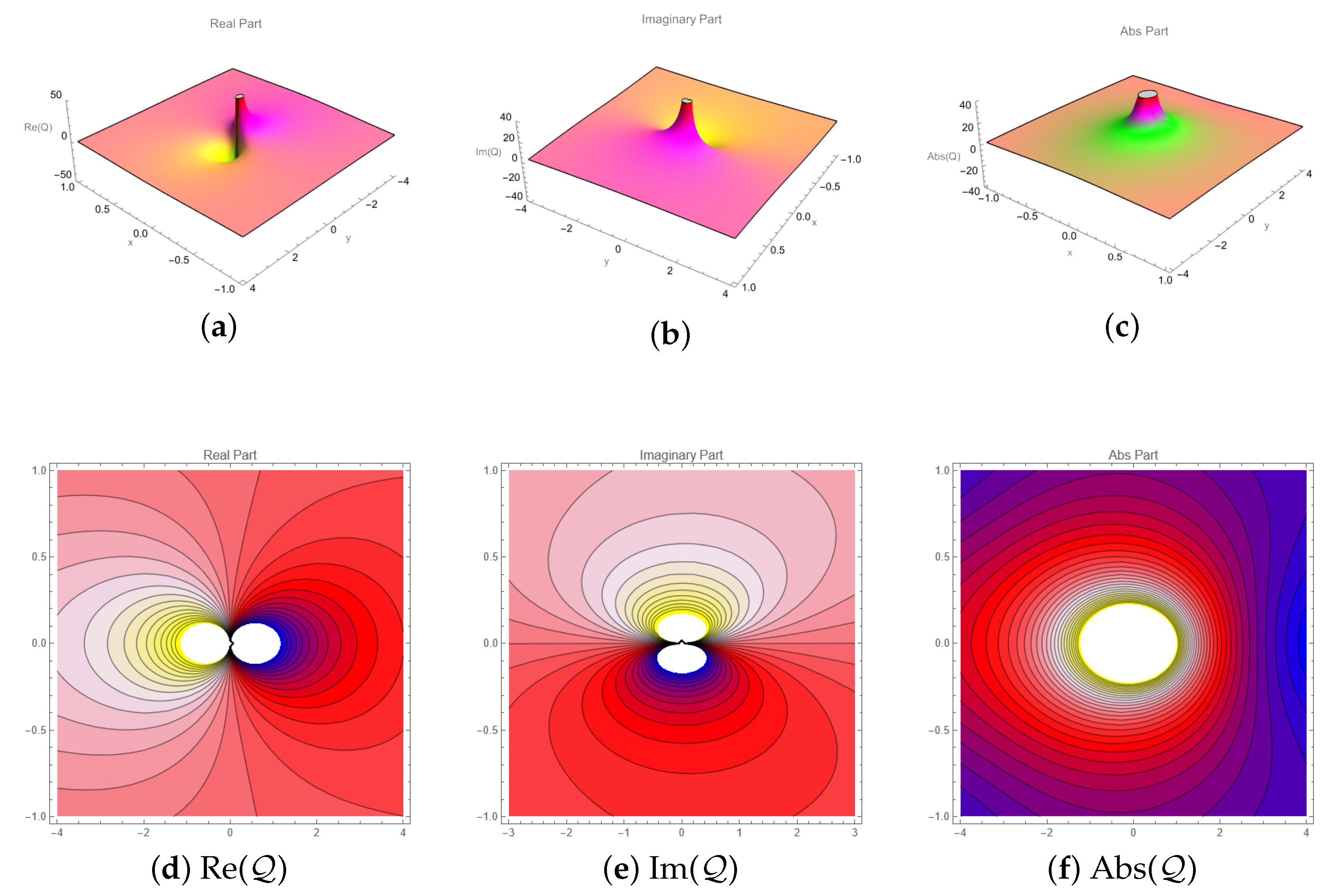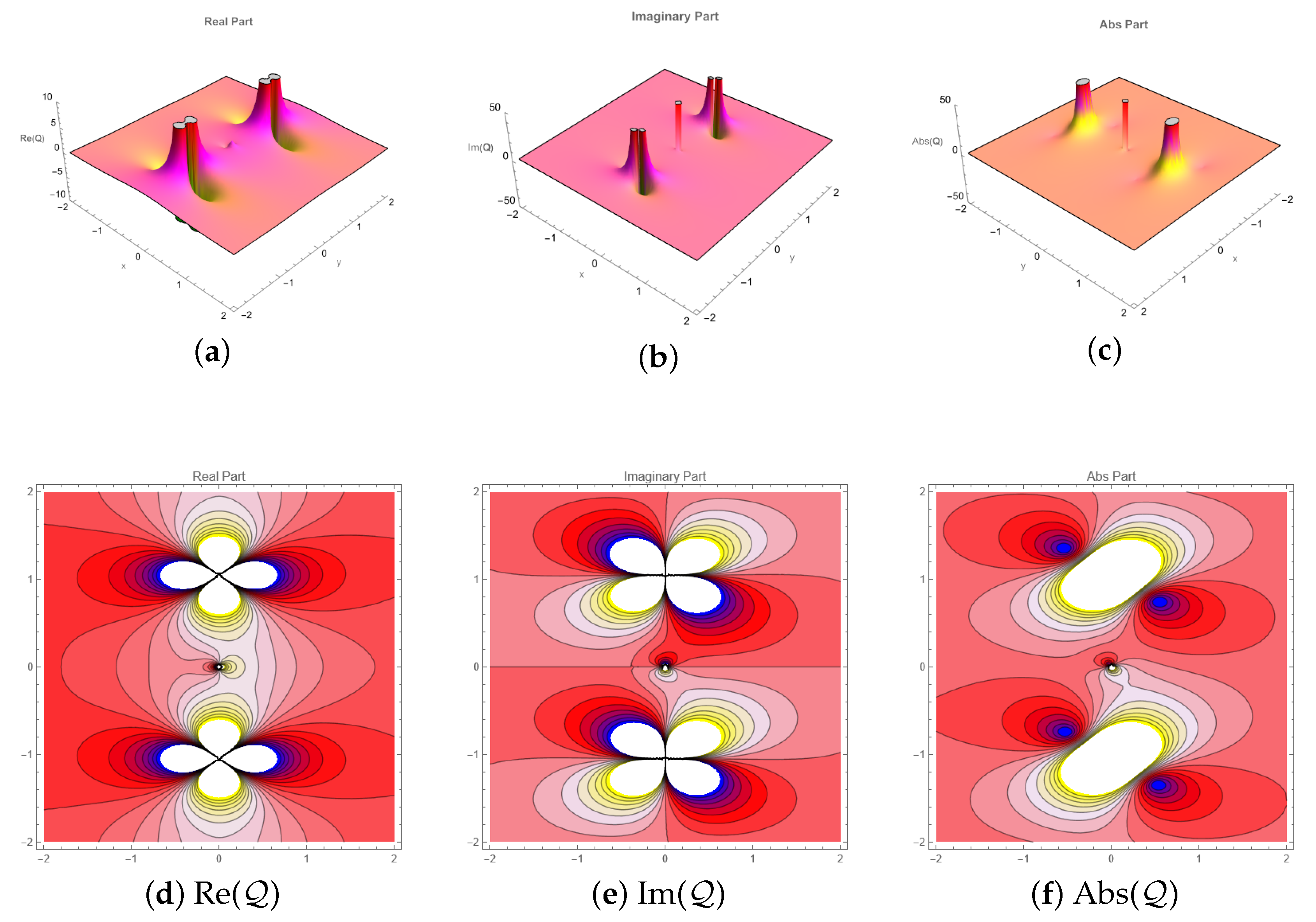Lie Symmetry Analysis, Rogue Waves, and Lump Waves of Nonlinear Integral Jimbo–Miwa Equation
Abstract
1. Introduction
1.1. Governing Model
1.2. Literature Review
1.3. Aim and Objectives of the Study
2. Methodology for Determining Lie Point Symmetries
- Step 1: Formulate a system of differential equations:The partial derivatives of can be represented using multi-index notation for a given order , considering independent variables and dependent variables .The notation represents the p-th order derivatives of for a fixed . The group transformations and are functions of and , respectively, and are defined according to Lie’s formulation.The generalized form of the prolongation formula is
- Step 2: To determine the coefficients and , the g-th prolongation of the vector field must be generated, applied to system (7), and enforced to vanish on its solution set. This results in a linear homogeneous PDE system for and , treating x and as independent variables. Known as the determining system for symmetries, it can be computed manually, interactively, or symbolically to obtain explicit expressions for and .
3. Lie Symmetry Analysis
4. Symmetry Reduction and Invariant Solution
4.1. Reduction Through Translation Invariance:
4.2. Reduction Through Translation Invariance:
4.3. Reduction Through Translation Invariance:
4.4. Reduction Through Translation Invariance:
4.5. Reduction Through Translation Invariance:
4.6. Reduction Through Translation Invariance:
5. Multivariate Generalized Exponential Rational Integral Function Method
- Step 01: The solution of Equation (89) is obtained through the MGERIF approach as outlined below.within this formulation, , , (with j = 1, 2, …, N) represents arbitrary constants, whereas the function is introduced asThe coefficients and exponents (i = 1, 2, 3, 4) act as free parameters in the solutions. By assigning specific values to these parameters, Equation (91) can be expressed in several known functional forms, as summarized in Table 3.
- Step 02: According to the principle of homogeneous balance, the positive integer N is obtained by comparing the order of the highest derivative term with that of the nonlinear term in Equation (89).
- Step 03: By inserting Equations (90) and (91) into Equation (89), a polynomial expression in terms of () is obtained. Imposing the condition that the coefficients of identical powers vanish results in a system of nonlinear algebraic equations. The simultaneous resolution of this system, together with Equation (91), leads directly to the solutions of Equation (2).
5.1. Solutions by MGERIF Method
5.2. The Standard Sine Form
- Case 1.1:
- Case 1.2:
- Case 1.3:
- Case 1.4:
5.3. The Standard Cosine Form
- Case 1.1:
- Case 1.2:
- Case 1.3:
- Case 1.4:
5.4. The Standard Exponential Form
- Case 1.1:
- Case 1.2:
- Case 1.3:
- Case 1.4:
5.5. The Standard Cosine Hyperbolic Form
- Case 1.1:
- Case 1.2:
- Case 1.3:
- Case 1.4:
5.6. The Standard Sine Hyperbolic Form
- Case 1.1:
- Case 1.2:
- Case 1.3:
- Case 1.4:
6. Graphical Description
7. Bridging Theory and Practice: Exploring Real-World Applications of Mathematical Innovations
8. Key Innovations
- The obtained solutions include a variety of functions such as logarithmic, exponential, trigonometric, and hyperbolic functions, along with various constants.
- To illustrate the physical characteristics of derived solutions, 3D, 2D, and contour graphs have been constructed using suitable constant values. The obtained solution exhibits a variety of solitary waves, including lumps, rogue waves, multi-solitons, and periodic waves.
- These results not only deepen our understanding of nonlinear waves in (3 + 1)-dimensions, but also apply to real-world fields, such as optics, plasma physics, material science, and optical communication.
9. Conclusions
Author Contributions
Funding
Data Availability Statement
Conflicts of Interest
Nomenclature
| t | Independent variable representing time |
| Independent spatial variables in the 3D domain | |
| Dependent variable/wave potential function | |
| Lie symmetry generators | |
| Infinitesimal generators corresponding to , respectively | |
| Infinitesimal generator for the dependent variable Q | |
| Similarity variable used in reductions (e.g., ) | |
| Constants in the similarity transformations | |
| Reduced function depending on similarity variable | |
| General form of the solution function used in the MGERIF method | |
| Arbitrary constants used in the solution ansatz | |
| Real parameters in the exact solution expressions | |
| Parameter representing frequency or modulation effects | |
| Z | Auxiliary function used in constructing solutions via the MGERIF method |
| Conditional indicators or case parameters in piecewise definitions of F | |
| Baseline offset; sets the background amplitude level of the solution. | |
| Controls the oscillatory or exponential envelope amplitude (e.g., sin, cos, sinh, cosh terms). Sign choice flips crests/troughs. Larger increases peak height and long-range tails. | |
| Governs localisation and effective width through squared terms (e.g., sin2, cos2,cosh2). Larger produces narrower, sharper peaks (more lump-like). | |
| Introduces rational-type contributions (sec, csc, sech, csch). Controls asymmetry and skewness of lobes in lump/rogue structures. | |
| Generates singular spike contributions (csc2, sech2, csch2). Dominant values produce highly-localised rogue-like peaks. | |
| Phase parameter. sets the translation/velocity of structures; induces exponential growth/decay and modulational focusing/defocusing, which can trigger rogue-like amplification. |
References
- Attia, R.A.; Xia, Y.; Zhang, X.; Khater, M.M. Analytical and numerical investigation of soliton wave solutions in the fifth-order KdV equation within the KdV-kP framework. Results Phys. 2023, 51, 106646. [Google Scholar] [CrossRef]
- Rabie, W.B.; Ahmed, H.M.; Mirzazadeh, M.; Akbulut, A.; Hashemi, M.S. Investigation of solitons and conservation laws in an inhomogeneous optical fiber through a generalized derivative nonlinear Schrödinger equation with quintic nonlinearity. Opt. Quantum Electron. 2023, 55, 825. [Google Scholar] [CrossRef]
- Ozdemir, N.; Secer, A.; Ozisik, M.; Bayram, M. Optical solitons for the dispersive Schrödinger–Hirota equation in the presence of spatiotemporal dispersion with parabolic law. Eur. Phys. J. Plus 2023, 138, 514. [Google Scholar] [CrossRef]
- Khater, M.M. Abundant and accurate computational wave structures of the nonlinear fractional biological population model. Int. J. Mod. Phys. B 2023, 37, 2350176. [Google Scholar] [CrossRef]
- Bialynicki-Birula, I.; Mycielski, J. Nonlinear wave mechanics. Ann. Phys. 1976, 100, 62–93. [Google Scholar] [CrossRef]
- Khater, M.M. Physics of crystal lattices and plasma; analytical and numerical simulations of the Gilson–Pickering equation. Results Phys. 2023, 44, 106193. [Google Scholar] [CrossRef]
- Ames, W.F. Nonlinear Partial Differential Equations in Engineering; Academic Press: New York, NY, USA, 1965. [Google Scholar]
- Stuart, J.T. On the non-linear mechanics of hydrodynamic stability. J. Fluid Mech. 1958, 4, 1–21. [Google Scholar] [CrossRef]
- Khater, M.M. Novel computational simulation of the propagation of pulses in optical fibers regarding the dispersion effect. Int. J. Mod. Phys. B 2023, 37, 2350083. [Google Scholar] [CrossRef]
- Abdou, M. A generalized auxiliary equation method and its applications. Nonlinear Dyn. 2008, 52, 95–102. [Google Scholar] [CrossRef]
- Lamb, G., Jr. Bäcklund transformations for certain nonlinear evolution equations. J. Math. Phys. 1974, 15, 2157–2165. [Google Scholar] [CrossRef]
- He, J.; Wu, X. Exp-function method for nonlinear wave equations. Chaos Solitons Fractals 2006, 30, 700–708. [Google Scholar] [CrossRef]
- Farooq, K.; Hussain, E.; Abujabal, H.A.; Alshammari, F.S. Propagation of nonlinear dispersive waves in shallow water and acoustic media in the framework of integrable Schwarz–Korteweg–de Vries equation. AIMS Math. 2025, 10, 17543–17566. [Google Scholar] [CrossRef]
- He, J. Homotopy perturbation method: A new nonlinear analytical technique. Appl. Math. Comput. 2003, 135, 73–79. [Google Scholar] [CrossRef]
- Farooq, K.; Tedjani, A.H.; Li, Z.; Hussain, E. Soliton dynamics of the nonlinear Kodama equation with M-truncated derivative via two innovative schemes: The generalized Arnous method and the Kudryashov method. Fractal Fract. 2025, 9, 436. [Google Scholar] [CrossRef]
- Hietarinta, J. Introduction to the Hirota bilinear method. In Integrability of Nonlinear Systems: Proceedings of the CIMPA School Pondicherry University, India, 8–26 January 1996; Springer: Berlin/Heidelberg, Germany, 2007; pp. 95–103. [Google Scholar]
- Gurefe, Y.; Misirli, E.; Sonmezoglu, A.; Ekici, M. Extended trial equation method to generalized nonlinear partial differential equations. Appl. Math. Comput. 2013, 219, 5253–5260. [Google Scholar] [CrossRef]
- Gu, C.; Hu, H.; Zhou, Z. Darboux Transformations in Integrable Systems: Theory and Their Applications to Geometry; Springer Science & Business Media: Berlin/Heidelberg, Germany, 2004. [Google Scholar]
- Kudryashov, N.A. Method for finding highly dispersive optical solitons of nonlinear differential equations. Optik 2020, 206, 163550. [Google Scholar] [CrossRef]
- Zhang, J.; Wei, X.; Lu, Y. A generalized -expansion method and its applications. Phys. Lett. A 2008, 372, 3653–3658. [Google Scholar] [CrossRef]
- Ahmed, K.I.A.; Mirgani, S.M.; Seadawy, A.; Saber, S. A comprehensive investigation of fractional glucose-insulin dynamics: Existence, stability, and numerical comparisons using residual power series and generalized Runge-Kutta methods. J. Taibah Univ. Sci. 2025, 19, 2460280. [Google Scholar] [CrossRef]
- Mirhosseini-Alizamini, S.M.; Rezazadeh, H.; Eslami, M.; Mirzazadeh, M.; Korkmaz, A. New extended direct algebraic method for the Tzitzica type evolution equations arising in nonlinear optics. Comput. Methods Differ. Eq. 2020, 8, 28–53. [Google Scholar]
- Abdelrahman, M.A.E.; Zahran, E.H.M.; Khater, M.M.A. The Exp(-ϕ(ξ))-expansion method and its application for solving nonlinear evolution equations. Int. J. Mod. Nonlinear Theory Appl. 2015, 4, 37–47. [Google Scholar] [CrossRef]
- Farooq, K.; Alshammari, F.S.; Li, Z.; Hussain, E. Soliton dynamics and stability in the Boussinesq equation for shallow water applications. Front. Phys. 2025, 13, 1637491. [Google Scholar] [CrossRef]
- Shah, S.A.A.; Hussain, E.; Ma, W.; Li, Z.; Ragab, A.E.; Khalaf, T.M. Qualitative analysis and new variety of solitons profiles for the (1 + 1)-dimensional modified equal width equation. Chaos Solitons Fractals 2024, 187, 115353. [Google Scholar] [CrossRef]
- Malik, S.; Kumar, S.; Das, A. A (2+1)-dimensional combined KdV–mKdV equation: Integrability, stability analysis and soliton solutions. Nonlinear Dyn. 2022, 107, 1–13. [Google Scholar] [CrossRef]
- Skipp, J.; Laurie, J.; Nazarenko, S. Hamiltonian derivation of the point vortex model from the two-dimensional nonlinear Schrödinger equation. Phys. Rev. E 2023, 107, 025107. [Google Scholar] [CrossRef] [PubMed]
- Farooq, K.; Hussain, E.; Younas, U.; Mukalazi, H.; Khalaf, T.M.; Mutlib, A.; Shah, S.A.A. Exploring the wave’s structures to the nonlinear coupled system arising in surface geometry. Sci. Rep. 2025, 15, 11624. [Google Scholar] [CrossRef]
- Alotaibi, T.; Althobaiti, A. Exact solutions of the nonlinear modified Benjamin-Bona-Mahony equation by an analytical method. Fractal Fract. 2022, 6, 399. [Google Scholar] [CrossRef]
- Zhou, Y.; Zhang, X.; Zhang, C.; Jia, J.; Ma, W. New lump solutions to a (3 + 1)-dimensional generalized Calogero–Bogoyavlenskii–Schiff equation. Appl. Math. Lett. 2023, 141, 108598. [Google Scholar] [CrossRef]
- Iqbal, M.A.; Wang, Y.; Miah, M.M.; Osman, M.S. Study on Date–Jimbo–Kashiwara–Miwa equation with conformable derivative dependent on time parameter to find the exact dynamic wave solutions. Fractal Fract. 2021, 6, 4. [Google Scholar] [CrossRef]
- Khater, M.M.A. Computational simulations of propagation of a tsunami wave across the ocean. Chaos Solitons Fractals 2023, 174, 113806. [Google Scholar] [CrossRef]
- Pu, X.; Zhou, W. The hydrostatic approximation of the Boussinesq equations with rotation in a thin domain. arXiv 2022, arXiv:2203.11418. [Google Scholar] [CrossRef]
- Haq, I.U.; Ali, N.; Ahmad, S.; Akram, T. A hybrid interpolation method for fractional PDEs and its applications to fractional diffusion and Buckmaster equations. Math. Probl. Eng. 2022, 2022, 2517602. [Google Scholar] [CrossRef]
- Faridi, W.A.; AlQahtani, S.A. The explicit power series solution formation and computation of Lie point infinitesimals generators: Lie symmetry approach. Phys. Scr. 2023, 98, 125249. [Google Scholar] [CrossRef]
- Dorizzi, B.; Grammaticos, B.; Ramani, A.; Winternitz, P. Are all the equations of the Kadomtsev–Petviashvili hierarchy integrable? J. Math. Phys. 1986, 27, 2848–2852. [Google Scholar] [CrossRef]
- Ma, W.-X.; Zhu, Z.-N. Solving the (3 + 1)-dimensional generalized KP and BKP equations by the multiple exp-function algorithm. Appl. Math. Comput. 2012, 218, 11871–11879. [Google Scholar] [CrossRef]
- Li, Z.; Dai, Z.; Liu, J. Exact three-wave solutions for the (3 + 1)-dimensional Jimbo–Miwa equation. Comput. Math. Appl. 2011, 61, 2062–2066. [Google Scholar] [CrossRef]
- Batwa, S.; Ma, W.-X. A study of lump-type and interaction solutions to a (3 + 1)-dimensional Jimbo–Miwa-like equation. Comput. Math. Appl. 2018, 76, 1576–1582. [Google Scholar] [CrossRef]
- Wazwaz, A.-M. Multiple-soliton solutions for the Calogero–Bogoyavlenskii–Schiff, Jimbo–Miwa and YTSF equations. Appl. Math. Comput. 2008, 203, 592–597. [Google Scholar] [CrossRef]
- Kumar, S.; Jadaun, V.; Ma, W.-X. Application of the Lie symmetry approach to an extended Jimbo–Miwa equation in (3 + 1) dimensions. Eur. Phys. J. Plus 2021, 136, 1–30. [Google Scholar] [CrossRef]
- Ahmed, S.; Rehman, U.; Fei, J.; Khalid, M.I.; Chen, X. Shallow-water wave dynamics: Butterfly waves, X-waves, multiple-lump waves, rogue waves, stripe soliton interactions, generalized breathers, and Kuznetsov–Ma breathers. Fractal Fract. 2025, 9, 31. [Google Scholar] [CrossRef]
- Ahmed, S.; Mubaraki, A.M. Pulse-driven robot: Motion via distinct lumps and rogue waves. Opt. Quant. Electron. 2024, 56, 225. [Google Scholar] [CrossRef]
- Wazwaz, A.-M. Multiple-soliton solutions for extended (3 + 1)-dimensional Jimbo–Miwa equations. Appl. Math. Lett. 2017, 64, 21–26. [Google Scholar] [CrossRef]
- Yue, Y.; Huang, L.; Chen, Y. Localized waves and interaction solutions to an extended (3 + 1)-dimensional Jimbo–Miwa equation. Appl. Math. Lett. 2019, 89, 70–77. [Google Scholar] [CrossRef]
- Meng, X. Rational solutions in Grammian form for the (3 + 1)-dimensional generalized shallow water wave equation. Comput. Math. Appl. 2018, 75, 4534–4539. [Google Scholar] [CrossRef]
- Sun, H.; Chen, A. Lump and lump–kink solutions of the (3 + 1)-dimensional Jimbo–Miwa and two extended Jimbo–Miwa equations. Appl. Math. Lett. 2017, 68, 55–61. [Google Scholar] [CrossRef]
- Deng, G.; Gao, Y.; Gao, X. Bäcklund transformation, conservation laws, solitary and periodic waves of an extended (3 + 1)-dimensional Jimbo–Miwa equation with time-dependent coefficients. Waves Random Complex Media 2018, 28, 468–487. [Google Scholar] [CrossRef]
- Yin, Y.; Chen, S.; Lü, X. Localized characteristics of lump and interaction solutions to two extended Jimbo–Miwa equations. Chinese Phys. B 2020, 29, 120502. [Google Scholar] [CrossRef]
- Manafian, J. Novel solitary wave solutions for the (3 + 1)-dimensional extended Jimbo–Miwa equations. Comput. Math. Appl. 2018, 76, 1246–1260. [Google Scholar] [CrossRef]
- Liu, J.; Yang, X.; Feng, Y.; Geng, L. Characteristics of new type rogue waves and solitary waves to the extended (3 + 1)-dimensional Jimbo–Miwa equation. J. Appl. Anal. Comput. 2021, 11, 1172–1188. [Google Scholar] [CrossRef] [PubMed]
- Xu, H.; Ruan, W.; Zhang, Y.; Lü, X. Multi-exponential wave solutions to two extended Jimbo–Miwa equations and the resonance behavior. Appl. Math. Lett. 2020, 99, 105976. [Google Scholar] [CrossRef]
- Liu, J.; Yang, X.; Feng, Y. On integrability of the extended (3 + 1)-dimensional Jimbo–Miwa equation. Math. Methods Appl. Sci. 2020, 43, 1646–1659. [Google Scholar] [CrossRef]
- Kara, S.; Ünsal, Ö. Implementation of two-variable expansion method for extended Jimbo–Miwa equations. J. Ocean Eng. Sci. 2022; in press. [Google Scholar] [CrossRef]
- Guo, H.; Xia, T.; Hu, B. High-order lumps, high-order breathers and hybrid solutions for an extended (3 + 1)-dimensional Jimbo–Miwa equation in fluid dynamics. Nonlinear Dyn. 2020, 100, 601–614. [Google Scholar] [CrossRef]
- Wang, K. Soliton molecules, Y-type soliton and complex multiple soliton solutions to the extended (3 + 1)-dimensional Jimbo-Miwa equation. Phys. Scr. 2024, 99, 015254. [Google Scholar] [CrossRef]
- Cheng, L.; Zhang, Y.; Ma, W.-X. Nonsingular complexiton solutions and resonant waves to an extended Jimbo–Miwa equation. Results Phys. 2021, 20, 103711. [Google Scholar] [CrossRef]
- Hydon, P.E. Symmetry Methods for Differential Equations: A Beginner’s Guide; Cambridge University Press: Cambridge, UK, 2000; Volume 22. [Google Scholar]
- Malik, S.; Kumar, S. Pure-cubic optical soliton perturbation with full nonlinearity by a new generalized approach. Optik 2022, 258, 168865. [Google Scholar] [CrossRef]
- AryaNejad, Y.; Jafari, M.; Mirzanand, R. Lie symmetry analysis of 3D unsteady diffusion and Reaction-Diffusion with singularities. Int. J. Math. Model. Comput. 2023, 13, 4. [Google Scholar] [CrossRef]
- Rafiq, M.H.; Raza, N.; Jhangeer, A.; Zidan, A.M. Qualitative analysis, exact solutions and symmetry reduction for a generalized (2 + 1)-dimensional KP–MEW-Burgers equation. Chaos Soliton. Fract. 2024, 181, 114647. [Google Scholar] [CrossRef]
- Almusawa, H.; Jhangeer, A. Soliton solutions, Lie symmetry analysis and conservation laws of ionic waves traveling through microtubules in live cells. Results Phys. 2022, 43, 106028. [Google Scholar] [CrossRef]
- Olver, P.J. Applications of Lie Groups to Differential Equations; Springer: New York, NY, USA, 1993; Volume 107. [Google Scholar] [CrossRef]
- Bocharov, A.V.; Krasil’shchik, I.S.; Vinogradov, A.M. Symmetries and Conservation Laws for Differential Equations of Mathematical Physics; American Mathematical Society: Providence, RI, USA, 1999; Volume 182. [Google Scholar] [CrossRef]
- Samreen, M.; Alshammari, F.S. Mathematical modeling, bifurcation theory, and chaos in a dusty plasma system with generalized (r★,q★) distributions. Axioms 2025, 14, 622. [Google Scholar] [CrossRef]
- Hussain, E.; Tedjani, A.H.; Farooq, K.; Beenish. Modeling and exploration of localized wave phenomena in optical fibers using the generalized Kundu–Eckhaus equation for femtosecond pulse transmission. Axioms 2025, 14, 513. [Google Scholar] [CrossRef]
- Asghari, Y.; Eslami, M.; Matinfar, M.; Rezazadeh, H. Novel soliton solution of discrete nonlinear Schrödinger system in nonlinear optical fiber. Alex. Eng. J. 2024, 90, 7–16. [Google Scholar] [CrossRef]
- Hamza, A.E.; Suhail, M.; Alsulami, A.; Mustafa, A.; Aldwoah, K.; Saber, H. Exploring Soliton Solutions and Chaotic Dynamics in the (3 + 1)-Dimensional Wazwaz–Benjamin–Bona–Mahony Equation: A Generalized Rational Exponential Function Approach. Fractal Fract. 2024, 8, 592. [Google Scholar] [CrossRef]










| 0 | 0 | 0 | 0 | |||||
| 0 | 0 | 0 | 0 | 0 | 0 | |||
| 0 | 0 | 0 | 0 | 0 | 0 | |||
| 0 | 0 | 0 | 0 | 0 | 0 | |||
| 0 | 0 | 0 | 0 | 0 | 0 | 0 | 0 | |
| 0 | 0 | 0 | 0 | 0 | ||||
| 0 | 0 | 0 | 0 | 0 | 0 | 0 | 0 | |
| 0 | 0 | 0 | 0 | 0 | 0 | 0 |
| Case | Non-Zero Coefficients | Resulting Generator | Subalgebra |
|---|---|---|---|
| 1 | |||
| 2 | |||
| 3 | |||
| 4 | |||
| 5 | |||
| 6 | |||
| 7 | |||
| 8 | |||
| 9 |
| Structure | Bilinear/Bell/Grammian | MGERIF (Via Lie Reduction) |
|---|---|---|
| Single traveling wave | 1-soliton from ; Q via . | Case 1.1 with : , giving (Equation (97)). |
| Two-component exponential form | 2-soliton . | Case 1.2 with : (Equation (99)) is a rational function in mixing first/second harmonics. |
| Mixed trigonometric–rational | Hard to write directly as with a finite exponential sum. | Case 1.3: combines , producing (Equation (101)). |
| Trigonometric family (phase shifted) | Standard sin/cos-based solitons. | : , yielding (Equation (107)). |
| Hyperbolic/bright–dark mix | forms are typical, but mixtures with are nontrivial. | : (Equation (135)) includes , giving – (Equations (137) and (138)). |
Disclaimer/Publisher’s Note: The statements, opinions and data contained in all publications are solely those of the individual author(s) and contributor(s) and not of MDPI and/or the editor(s). MDPI and/or the editor(s) disclaim responsibility for any injury to people or property resulting from any ideas, methods, instructions or products referred to in the content. |
© 2025 by the authors. Licensee MDPI, Basel, Switzerland. This article is an open access article distributed under the terms and conditions of the Creative Commons Attribution (CC BY) license (https://creativecommons.org/licenses/by/4.0/).
Share and Cite
Hussain, E.; Abdullah, A.R.; Farooq, K.; Shah, S.A.A. Lie Symmetry Analysis, Rogue Waves, and Lump Waves of Nonlinear Integral Jimbo–Miwa Equation. Symmetry 2025, 17, 1717. https://doi.org/10.3390/sym17101717
Hussain E, Abdullah AR, Farooq K, Shah SAA. Lie Symmetry Analysis, Rogue Waves, and Lump Waves of Nonlinear Integral Jimbo–Miwa Equation. Symmetry. 2025; 17(10):1717. https://doi.org/10.3390/sym17101717
Chicago/Turabian StyleHussain, Ejaz, Aljethi Reem Abdullah, Khizar Farooq, and Syed Asif Ali Shah. 2025. "Lie Symmetry Analysis, Rogue Waves, and Lump Waves of Nonlinear Integral Jimbo–Miwa Equation" Symmetry 17, no. 10: 1717. https://doi.org/10.3390/sym17101717
APA StyleHussain, E., Abdullah, A. R., Farooq, K., & Shah, S. A. A. (2025). Lie Symmetry Analysis, Rogue Waves, and Lump Waves of Nonlinear Integral Jimbo–Miwa Equation. Symmetry, 17(10), 1717. https://doi.org/10.3390/sym17101717








